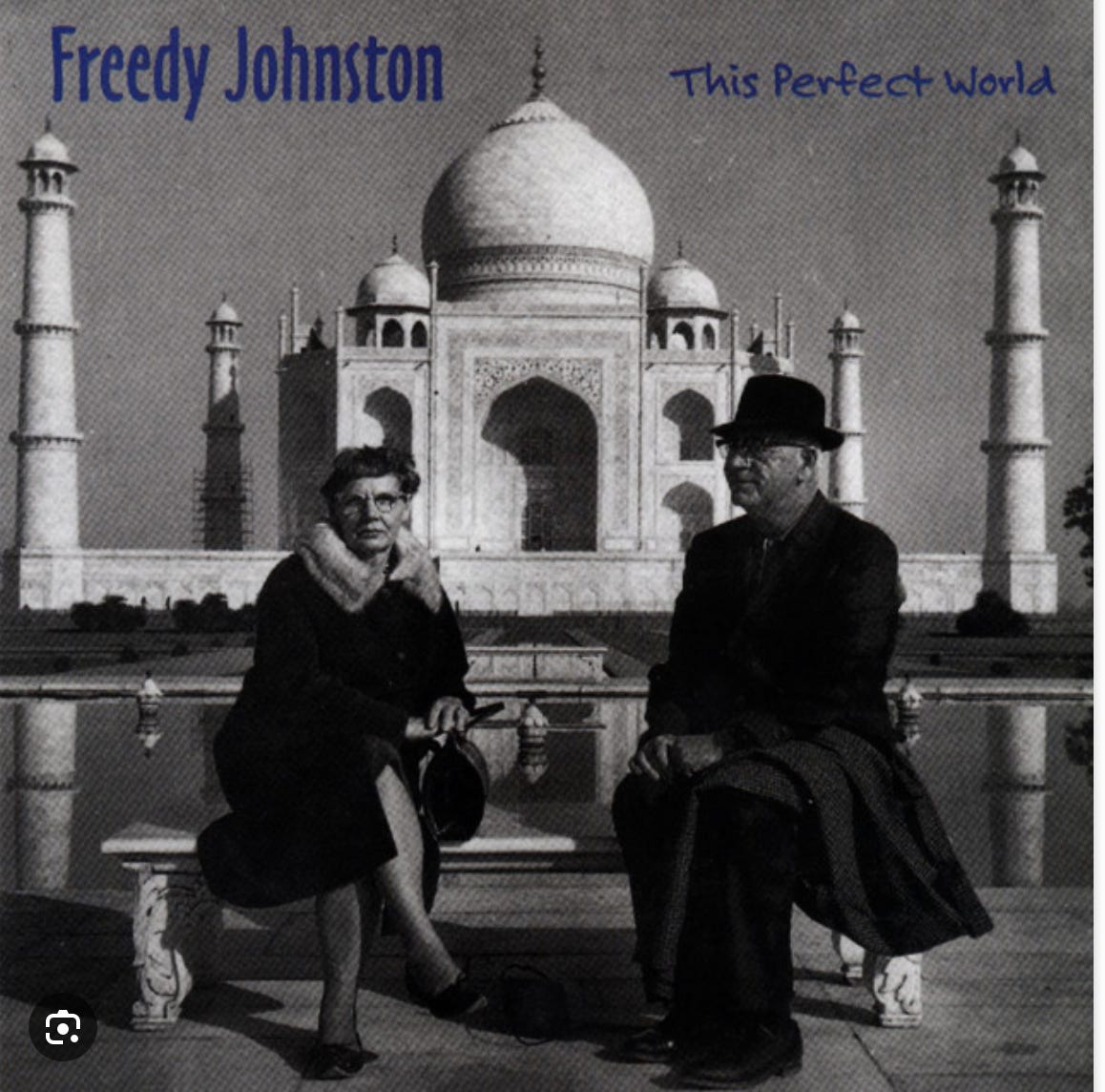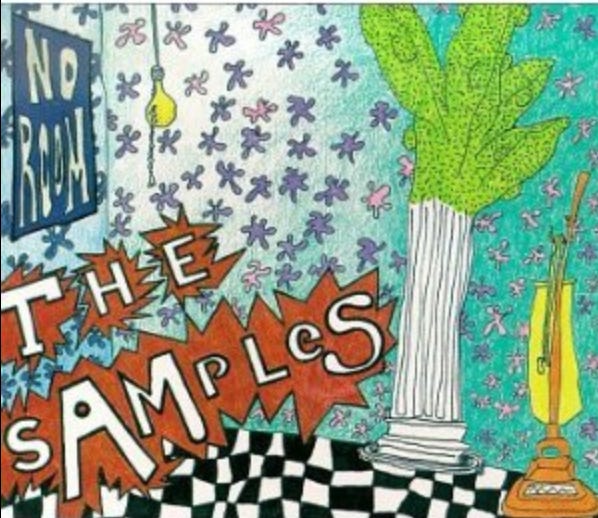90 Songs That Explain My 90s: Volume 1
Drafting off of Rob Harvila's pretty popular podcast, five songs at a time
Inspired by Rob Harvila’s podcast 60 Songs That Explain The ‘90s, in which he reads sprawling and personal and funny and weird and rambling essays about songs that explain how the ‘90s were, I thought I’d write my own version: 90 Songs That Explain My ‘90s1. No sprawling essays, though. Just blurbs. Or essay-sized blurbs.
And how about an ongoing playlist where I’ll dump the songs as I write about them, around five at a time.
Wanna listen along? Here’s the playlist on Spotify (with no Neil Young because he’s not on Spotify, so I added another of my favorite songs by one of the artists). And on Apple Music (which does have Neil Young, thank goodness).
Let’s start right in my singer-songwriter wheelhouse.
1. Freedy Johnston- Bad Reputation (1994) Freedy Johnston was a substantial factor in my conversion into a fan (and creator) of singer-songwriter/Americana. Pre-Freedy, my musical taste trafficked primarily in classic rock, “alternative” rock, with a bit of reggae2 and folk and just the slightest bit of rap (would a real rap fan say “slightest bit” of anything? Can you imagine 50 Cent’s “Just A Lil Bit” instead being titled “Just The Slightest Bit” which sounds like an unreleased Mary Poppins b-side). Freedy was kind of a gateway to less-heartland-y, more Beatle-influenced songwriters like Aimee Mann and Elliott Smith. His dark, character-study songs also prepped me for my eventual love of Tom Waits’ songs, in the spirit of “beautiful melodies telling me terrible things.” I’ll probably do an Underrated Artist post all about Freedy, who only has ONE song that’s been streamed over 1 million.

2. Aimee Mann- Save Me (1999) Speaking of Aimee Mann, my introductory dose was her song “That’s Just What You Are”3 from the mid-90s. I think it was featured in an episode of the soap opera Melrose Place4? But “Save Me” was the knockout punch. Mann gave me nearly everything I loved about my precious Beatles but in a postmodern way, with more irony and self-loathing, which is saying something when you’re comparing an artist to John Lennon. One thing I love about this song is how it takes a pretty complex idea—that someone is falling apart and looking to others for support—and distills it down. Plus the melody and chords together have a real White Album feel to them. Honorable mention to Mann’s song “Deathly” with its epic electric guitar outro and its hall-of-fame opening line:
Now that I’ve met you
Would you object to
Never seeing each other again?

3. Neil Young- Harvest Moon (1992) I don’t know how you talk about the 90s without talking about the huge Neil Young-aissance. Kicking off with Freedom in 89, then Ragged Glory, then the live tour de force Weld, then Harvest Moon, then Unplugged, Sleeps With Angels, Mirror Ball with the then-hottest-rock-band-on-the-planet Pearl Jam, Broken Arrow, and then Silver & Gold in 2000. Compare that to Neil’s 60s/70s peers’ output during the same period (Stephen Stills? Roger McGuinn?) and it’s no contest5. Maybe even embarrassing. Even without that context, it was quite a run. I’ve said it before and I’ll say it again: Neil Young & Crazy Horse with Sonic Youth and Social Distortion at the Huntsman Center in Salt Lake was one of the best (and loudest) concerts I’ve ever attended.
Let’s break up the singer-songwriter streak with a wild card. And, oh, how wild.
4. Mamonas Assassinas- Pelados Em Santos (1995) The most famous group in Brazil while I was on my LDS mission in São Paulo. How’s that for a one-sentence exercise in extremes? They were, hmmm…what’s the delicate way to put this….playfully transgressive? Idiotically offensive? Sophomorically in your face? These guys were the farthest thing from delicate, so let’s leave it at this: their name, translated, means “Killer Big Boobs” (reflected on the high school graphics class album cover art) and the translated title of this song is “Naked in Santos.” They recorded just this one filthy-dumb album and you could hear this song every single day out on the streets. It was unavoidable. Then one day (March 2, 1996, to be specific), their plane crashed into the Cantareira mountains and they all died. The Brazilian newspapers, with different media regulations than we have here in the U.S., printed unbelievably graphic photos of the wreckage. I’ll never forget seeing what they said was one of lead singer Dinho’s arms. Just strewn there, amid the wreckage and trees. Wild. And, after that, you’d hear the song every single hour out on the streets. (For the record, I don’t even like the song. It’s objectively hacky and bad. But it was everywhere and absolutely explains a piece of my two years in Brazil.)
5. The Samples- Nothing Lasts For Long (1992) Salt Lake City had to be one of Colorado jamband The Samples’ top 3 markets. For a certain demographic (ok, my friend group) at my high school, they were as big as any other band of the era. East High School single-handedly kept The Samples in business long after their Icarus-like leap for the big time melted (they were seemingly always on the verge of breaking through and many bands that opened for them—Dave Matthews Band, in particular—hit the big time). My high school band covered this song, sentimental as all get out, for our Senior Assembly our Senior year. It had to do with changes, youth, high school, relationships, and so many more things that hit hard for a sentimental 17-year old. On that stage, I was feeling all the feels (though, thankfully, we didn’t say it like that back then). My friend/bandmate Adam sang this one. I still can’t hit any of the notes that lead singer Sean Kelly hit. (My actual favorite Samples song is probably “Feel Us Shaking”, “Birth of Words”, or “When It’s Raining.”)

Stay tuned for the next 5, coming eventually!
“Wait,” you say, “the original podcast is only 60 songs. Why are you going to 90, Paul?” The truth is: Harvila exceeded his original, titular 60 songs long ago and is currently on record as capping the podcast at, I believe, 120 songs. As a writer, I liked the symmetry of two nineties, so that’s where I stuck.
A couple years ago, my son came home from a friend’s house, all performatively ticked off that I’d never introduced him to the music of Bob Marley. I had neglected him, he said. “What gives, Dad?!? Why didn’t you show me Bob Marley?” My response was that he didn’t need me to find the undisputed king of reggae (and college dorm room posters) Bob Marley. Bob Marley would find him. Bob Marley was everywhere. My job is to get other stuff onto my kids’ radar….Spoon and Kathleen Edwards and Fugazi and Elvis Costello and Toots & The Maytals. Speaking of whom, I instantly put on Toots’ “Time Tough”, to illustrate where else reggae went, beyond Bob.
“That’s Just What You Are” was co-written by my musical hero Jon Brion, long before I ever knew that I was going to love nearly everything Jon Brion touches.
One of my 90s celebrity crushes was Heather Locklear, who originally smote me when she co-starred on the William Shatner cop-tv vehicle TJ Hooker. We don’t mention her spotty dating life involving members of Motley Crue and Bon Jovi.
I have an exquisitely nerdy Google Sheets spreadsheet. Wanna see it?
I created (am creating still) the spreadsheet in an attempt to track artists’ creativity/productivity over time. Someday, I’ll dive into it more deeply here. It’s a lot to parse and isn’t really complete yet anyway. But the basic idea is that an artist’s first recorded song marks the beginning on the chart and, from there, I track their output year by year to see where their commercial (and critical) peaks are. I’m looking for patterns; I’m also looking for outliers. Who had an impressive late career? Who peaked early? Whose path is more up and down? Anyway, with the limited artists I’ve tracked so far, let’s just say that the only peers—qualitatively speaking—that Neil Young has roundabout their 35th year as a recording artist? Here’s my list, using just one album per artist, acknowledging that there are more than a few for many of them and that I haven’t accounted for tons of worthy artists (like, I have zero jazz musicians so far):
John Prine- Fair & Square
Bob Dylan- Time Out Of Mind
Randy Newman- Bad Love
Johnny Cash- American Recordings
Loretta Lynn/Dolly Parton/Tammy Wynette- Honky Tonk Angels
David Byrne - Love This Giant (with St. Vincent)
Paul Simon- So Beautiful or So What (year 48!)
David Bowie- Blackstar (year 50!)
Leonard Cohen- You Want It Darker (year 50!)
Bonnie Raitt- Just Like That (year 51!!!)
Tom Waits- Orphans








This is fun, Paul. With reference to your footnote 5, if Yo La Tengo had a place in your spreadsheet, would they make the list as a peer of Neil Young? They're more than 35 years in and they're still as good as ever.
I'm looking forward to the rest of your 90.